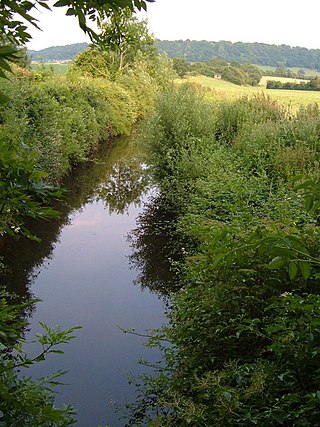William Bennet (or Bennett) was an English civil engineer, noted for his work on canals. Nothing is known of his early life or family history, but details of his work from about 1790 until 1826 are documented. His major projects were for the Dorset and Somerset Canal and the Somersetshire Coal Canal.
It is thought that Bennet originated in Lancashire, as his first recorded projects concerned surveying of an extension to the Manchester, Bolton and Bury Canal from Bolton to join the Leeds Liverpool Canal, then being proposed, and surveying of the Bury and Sladen Canal, to create a link to the Rochdale Canal. The surveys were completed in 1792, after which he surveyed a canal from Accrington to Bury, which although it obtained an Act of Parliament in 1794 to authorise its construction, was never built. During this period he met Robert Whitworth, who employed him for a time, and was influential in his move to projects in the South West. [1]
Whitworth had been approached by the Dorset and Somerset Canal Committee, with a view to him surveying that scheme, but felt that he was too busy with other work, and so recommended Bennet as a suitable alternative in 1793. Bennet was at the time busy with plans for the Ivelchester and Langport Navigation, and so did not complete the Dorset and Somerset plans until mid-1795. The committee rejected the final part of his route, which would have joined the Kennet and Avon Canal at Dundas Aqueduct, but accepted a revised route to Widbrook on 13 August 1795. [1]
Bennet estimated the cost at £146,008, and presented evidence on the engineering aspects of the project, which enabled the committee to obtain an Act of Parliament in 1796. The scheme involved caisson locks, on which Robert Weldon held a patent, and although construction of the canal began in September 1796, Bennet deferred any work on the locks until the outcome of trials on the neighbouring Somersetshire Coal Canal were known. Since November 1795, Bennet had also been the engineer for that scheme. [1]
It was estimated that the use of caisson locks could save the Somersetshire Canal Company around £10,000, but the trials were not successful. Bennet was consulted when the brickwork forming the lock walls started to bulge, but Benjamin Outram was approached in February 1800, and he recommended replacing the locks with an inclined plane. Bennet assessed Outram's proposal, and three other proposals for balance locks, by James Fussell, Norton and Whitmore. Although he wanted to proceed with a lock scheme, the decision to build an inclined plane was made in June 1800, but that was not a success. The Company obtained a new Act or Parliament in 1802 to authorise its replacement by a flight of conventional locks, but by 1806 it became evident that Bennet had underestimated the cost by a third, and he was dismissed. [1]
On the Dorset and Somerset Canal, Bennet had to decide what to do when the lock trials showed the flaws in Weldon's caisson locks. He recommended locks based on a patent by James Fussell, and although the first trial was a success, the scheme ran out of money in 1802, and was never completed. [1]
Very little is known of his subsequent career. He was involved with an inclined plane from Bathampton Quarries to the Kennet and Avon Canal in 1808, and he worked with Robert Anstice advising on the River Axe drainage scheme, also in 1808. Between 1821 and 1825, he was resident in Eccles Green, Lancashire, and produced a report jointly with Thomas Tredgold in 1825, on using the route of the abortive Dorset and Somerset Canal for a railway. [1]

The Kennet and Avon Canal is a waterway in southern England with an overall length of 87 miles (140 km), made up of two lengths of navigable river linked by a canal. The name is used to refer to the entire length of the navigation rather than solely to the central canal section. From Bristol to Bath the waterway follows the natural course of the River Avon before the canal links it to the River Kennet at Newbury, and from there to Reading on the River Thames. In all, the waterway incorporates 105 locks.

The Wilts & Berks Canal is a canal in the historic counties of Wiltshire and Berkshire, England, linking the Kennet and Avon Canal at Semington near Melksham, to the River Thames at Abingdon. The North Wilts Canal merged with it to become a branch to the Thames and Severn Canal at Latton near Cricklade. Among professional trades boatmen, the canal was nicknamed the Ippey Cut, possibly short for Chippenham.

The Dorset and Somerset Canal was a proposed canal in southwestern England. The main line was intended to link Poole, Dorset with the Kennet and Avon Canal near Bradford on Avon, Wiltshire. A branch was to go from the main line at Frome to the southern reaches of the Somerset coalfield at Nettlebridge. Construction of the branch started in 1786, using boat lifts rather than locks to cope with changes of level, but the company ran out of money and the canal was abandoned in 1803, never to be completed.

A lock is a device used for raising and lowering boats, ships and other watercraft between stretches of water of different levels on river and canal waterways. The distinguishing feature of a lock is a fixed chamber in which the water level can be varied; whereas in a caisson lock, a boat lift, or on a canal inclined plane, it is the chamber itself that rises and falls.
The Grand Western Canal ran between Taunton in Somerset and Tiverton in Devon in the United Kingdom. The canal had its origins in various plans, going back to 1796, to link the Bristol Channel and the English Channel by a canal, bypassing Lands End. An additional purpose of the canal was the supply of limestone and coal to lime kilns along with the removal of the resulting quicklime, which was used as a fertiliser and for building houses. This intended canal-link was never completed as planned, as the coming of the railways removed the need for it.

A boat lift, ship lift, or lift lock is a machine for transporting boats between water at two different elevations, and is an alternative to the canal lock.

The Chard Canal was a 13.5 miles (21.7 km) tub boat canal in Somerset, England, that ran from the Bridgwater and Taunton Canal at Creech St. Michael, over four aqueducts, through three tunnels and four inclined planes to Chard. It was completed in 1842, was never commercially viable, and closed in 1868. The major engineering features are still clearly visible in the landscape.
Francis Giles was an English canal engineer and surveyor who worked under John Rennie and later became a railway engineer.

The Somerset Coal Canal was a narrow canal in England, built around 1800. Its route began in basins at Paulton and Timsbury, ran to nearby Camerton, over two aqueducts at Dunkerton, through a tunnel at Combe Hay, then via Midford and Monkton Combe to Limpley Stoke where it joined the Kennet and Avon Canal. This link gave the Somerset coalfield access east toward London. The longest arm was 10.6 miles (17.1 km) long with 23 locks. From Midford an arm also ran via Writhlington to Radstock, with a tunnel at Wellow.

Southcote Lock is a lock on the Kennet Navigation at Southcote near the town of Reading in Berkshire, England. It has a rise/fall of 5 feet 3 inches (1.60 m).
Josias Jessop (1781–1826) was a canal engineer, and second son of William Jessop, one of the great canal engineers of the late eighteenth and early nineteenth centuries. He was trained by his father, and worked under him on his early projects, but proved his abilities during the construction of Bristol harbour. He became an independent consulting engineer from 1811. He died fourteen years later, a little before he reached the age of 45.

The balance lock was a type of boat lift designed by James Fussell (1748-1832) to transport boats up and down a hillside on a canal. An experimental balance lock was built as part of the Dorset and Somerset Canal and work was started for four more, but the project failed for financial reasons and they were not completed.

The caisson lock is a type of canal lock in which a narrowboat is floated into a sealed watertight box and raised or lowered between two different canal water levels. It was invented in the late 18th century as a solution to the problem posed by the excessive demand for water when conventional locks were used to raise and lower canal boats through large height differences. Such locks, each of which would only raise and lower boats through small height differences of a few feet, would not suffice when large height differences had to be tackled nor when water was in short supply. The caisson was thought to be one solution, although it transpired that the technology of the day was not capable of achieving this type of construction economically.

John Hore was an English engineer, best known for making the River Kennet and River Avon navigable. Hore was one of the earliest English canal engineers, and Sir Alec Skempton wrote that he was "in the first rank among the navigation engineers". The Hutchinson Chronology of World History described his work on the Kennet navigation as "[setting] a new standard for inland waterways, and is an important forerunner of the canals of the Industrial Revolution".
Josiah Clowes (1735–1794) was an English civil engineer and canal builder. His early years were spent running a canal carrying company with Hugh Henshall, and although he worked on some canal projects before 1783, that year marked his switch to being an engineer. His first major project included the Sapperton Tunnel on the Thames and Severn Canal, which despite huge engineering difficulties, gained him a reputation which enabled him to become the first great tunnelling engineer, responsible for three of the four longest canal tunnels built.
James Green (1781–1849) was a civil engineer and canal engineer, who was particularly active in the South West of England, where he pioneered the building of tub boat canals, and inventive solutions for coping with hilly terrain, which included tub boat lifts and inclined planes. Although dismissed from two schemes within days of each other, as a result of construction problems, his contribution as a civil engineer was great.
The Berks and Hants Canal, incorporated as the Berkshire and Hampshire Junction Canal Company, was a proposed canal in the English counties of Berkshire and Hampshire. Proposals for the waterway originate after the completion of the Kennet and Avon Canal and the Basingstoke Canal in the 1790s, with a view to connecting the two canals.
John Blackwell was an English civil engineer, known for his work as superintending engineer of the Kennet and Avon Canal under John Rennie and later as the canal company's resident engineer.

The Combe Hay Locks is a derelict flight of locks on the Somerset Coal Canal near Combe Hay, Somerset, England. Twenty two locks raised the canal 134 feet (41 m) over approximately 1.6 miles (2.6 km). The lock flight was predated in the immediate area by two other methods of canal lifts—first by a series of caisson locks, then by an inclined plane. The lock flight opened in 1805, and was in operation until 1899.